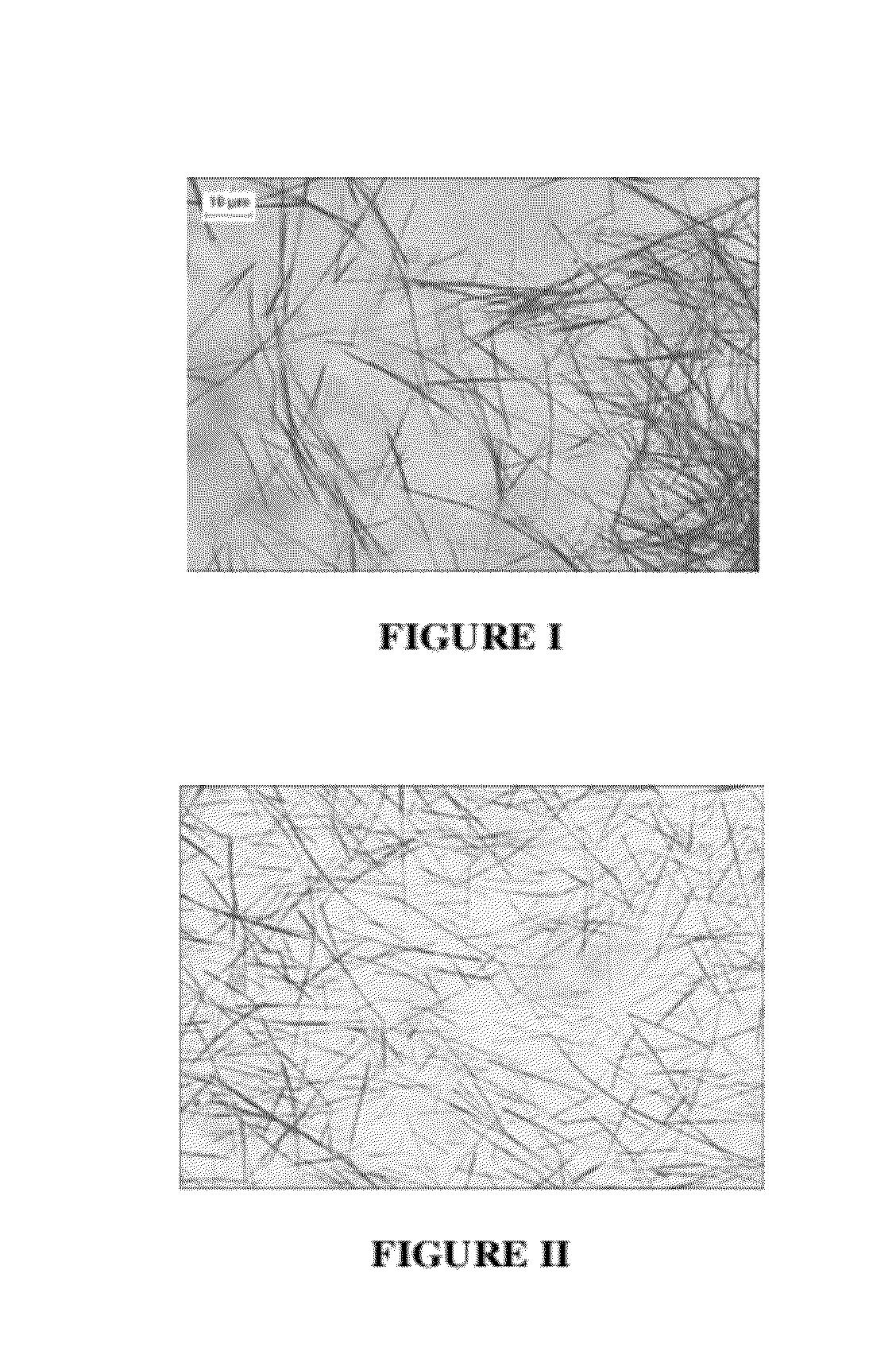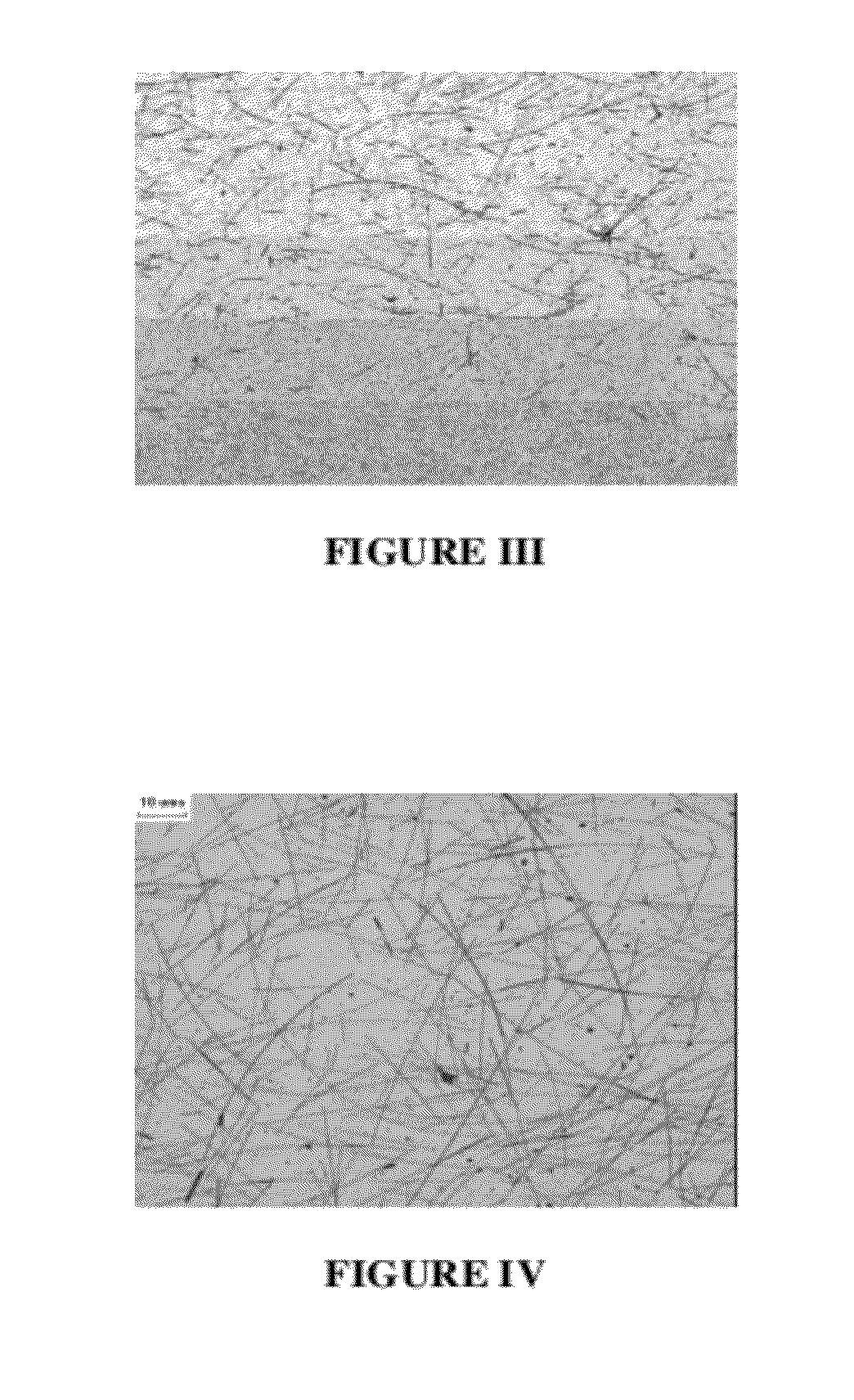Transparent conductive film comprising water soluble binders
- Summary
- Abstract
- Description
- Claims
- Application Information
AI Technical Summary
Benefits of technology
Problems solved by technology
Method used
Image
Examples
examples 1 , 4 , 5
Examples 1, 4, 5, and 6
[0082]To a solution of 0.5 g of the polymer premix solution, as shown below in TABLE II, was added 0.4 g of deionized water, 0.10 g of a silver nanowire dispersion in 2-propanol (5.09% silver nanowires) and 0.01 g of Zonyl FS-300.
[0083]The dispersion was mixed on a roller mixer for 10 minutes to obtain a uniform dispersion. The dispersion was coated onto a 7-mil (178 μm) clear polyethylene terephthalate support using a #10 Mayer rod. The resulting coating was dried in oven at 220° F. (104° C.) for 10 min to obtain a transparent film suitable for testing.
[0084]Samples were tested for surface resistivity, % transmission, and adhesion to the support as described above.
Preparation of Transparent Conductive Films
examples 2 and 3
[0085]To a solution of 0.5 g of the polymer premix solution, as shown below in TABLE II, was added 0.3 g of deionized water, 0.10 g of a silver nanowire dispersion in 2-propanol (5.09% silver nanowires).
[0086]The dispersion was mixed on a wrist shaker for 5 minutes to obtain a uniform dispersion. The dispersion was coated onto a 7-mil (178 μm) clear, gel-subbed polyethylene terephthalate support using a #11 Mayer rod. The resulting coating was dried in oven at 210° F. (98.9° C.) for 5 min to obtain a transparent film suitable for testing.
[0087]Samples were tested for surface resistivity, % transmission, and adhesion to the support as described above.
[0088]The results, shown below in TABLE I, demonstrate that transparent conductive films, coated from polyvinyl alcohol or gelatin have a much lower resistivity than transparent conductive films similarly prepared, but using a water dispersed polyurethane binder.
[0089]Photographs of samples of films prepared in Examples 2 and 5 were take...
examples 7 , 8
Examples 7, 8, and 9
[0092]To a solution of 0.4 g of gelatin premix solution melted at 50° C., prepared as shown in TABLE III, was added 0.7 g of deionized water, 0.016 g of 1% Larostat 264A in deionized water, 0.05 g of 1% BVSM in water (gelatin crosslinker), and 0.1 g of a silver nanowire dispersion in 2-propanol (5.5% silver nanowires).
[0093]The resulting solution was mixed on a wrist shaker for 5 minutes to obtain a uniform dispersion. The dispersion was coated onto a 4-mil (102 μm) clear, gel-subbed polyethylene terephthalate support using a #10 Mayer rod. The resulting coating was dried at 205° F. (96.1° C.) for 5 minutes to obtain a transparent film suitable for testing.
[0094]Samples were tested for surface resistivity, % transmission, and adhesion to the support as described above.
Preparation of Transparent Conductive Film
PUM
| Property | Measurement | Unit |
|---|---|---|
| Transparency | aaaaa | aaaaa |
| Nanoscale particle size | aaaaa | aaaaa |
| Nanoscale particle size | aaaaa | aaaaa |
Abstract
Description
Claims
Application Information
 Login to View More
Login to View More - R&D
- Intellectual Property
- Life Sciences
- Materials
- Tech Scout
- Unparalleled Data Quality
- Higher Quality Content
- 60% Fewer Hallucinations
Browse by: Latest US Patents, China's latest patents, Technical Efficacy Thesaurus, Application Domain, Technology Topic, Popular Technical Reports.
© 2025 PatSnap. All rights reserved.Legal|Privacy policy|Modern Slavery Act Transparency Statement|Sitemap|About US| Contact US: help@patsnap.com



